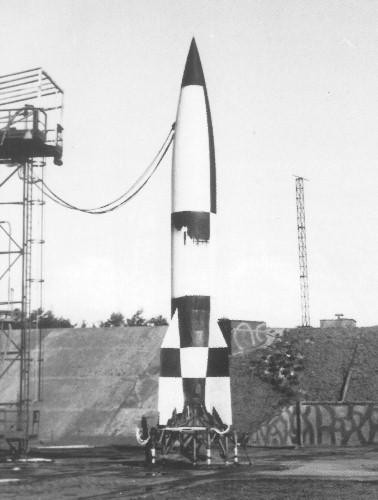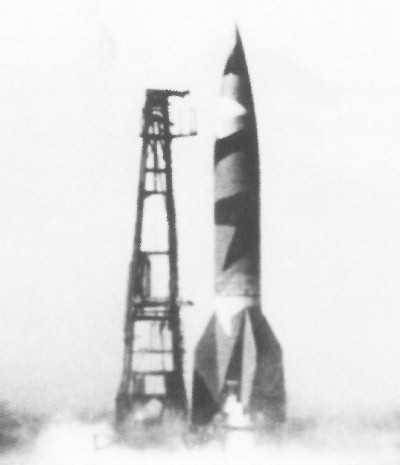The German V-2 (A-4) in WWII
| Launch of a German V-2 rocket by American personnel at White Sands Proving Ground, New Mexico in March 1948. Americans gained much in the way of knowledge and experience by launching captured V-2s. |
The V-2 launched by Germany against its enemies in WWII was a ballistic missile of relatively short range, but it foreshadowed the development of a larger liquid propellant rocket engine that was the predecessor of more powerful rocket engines developed for modern space flight. Much of the basic theory used by German scientists in the development of the engine for the V-2 came from experimentation by Dr. Robert Goddard in the United States. Post-war American liquid fueled rocket engines evolved directly from the German engine that powered the V-2 weapon. Thus it was that the engines eventually used in U.S. Air Force space boosters owed much to the V-2 engine and the improvements that followed. In February 1949 an American WAC Corporal second stage rocket carried atop a modified V-2 booster sent a payload 250 miles into the vacuum of space on a short suborbital flight. Mankind had taken its first real step into space.
|
 |
 |
The rocket engine used in a German V-2 missile during WWII.
Launch of the Bumper WAC Corporal on February 24, 1949 at White Sands Proving Ground, New Mexico. An American designed WAC Corporal rocket served as the second stage to the German built V-2 first stage.
Hiçbir yazı/ resim izinsiz olarak kullanılamaz!! Telif hakları uyarınca bu bir suçtur..! Tüm hakları Çetin BAL' a aittir. Kaynak gösterilmek şartıyla siteden alıntı yapılabilir.
The Time Machine Project © 2005 Cetin BAL - GSM:+90 05366063183 -Turkiye/Denizli
Ana Sayfa /index /Roket bilimi /![]() E-Mail /CetinBAL/Quantum Teleportation-2
E-Mail /CetinBAL/Quantum Teleportation-2
Time Travel Technology /Ziyaretçi Defteri /UFO Technology/Duyuru